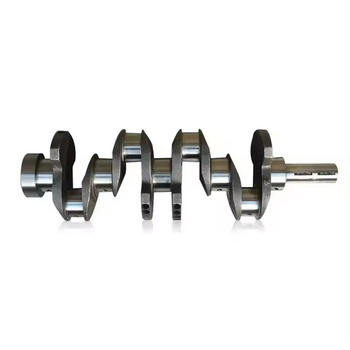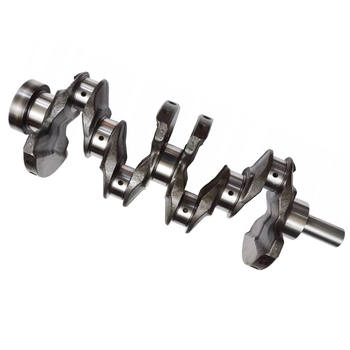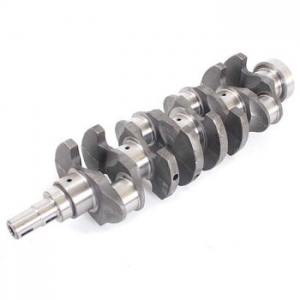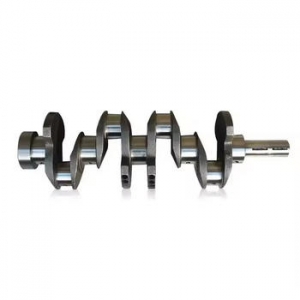Unlocking Power: A Deep Dive into Heavy Duty Crankshaft Material Properties
Have you ever stopped to consider what truly makes a heavy-duty engine tick? Beyond the roar and the raw power, there's an intricate dance of engineering and material science happening within its core. At the heart of it all lies the crankshaft, the component responsible for converting the linear motion of the pistons into rotational energy that drives everything from massive trucks to industrial machinery. But it's not just any crankshaft; for heavy-duty applications, the demands are immense, and frankly speaking, the choice of material is paramount.
To be honest, when we talk about the longevity and performance of a high-stress engine component, it all boils down to the heavy duty crankshaft material properties. These aren't just arbitrary choices; they are meticulously selected and processed to ensure the crankshaft can withstand relentless torsional stresses, bending forces, and cyclic fatigue over millions of revolutions. Without the right material, even the most perfectly designed crankshaft would quickly succumb to the brutal realities of its operational environment. In my experience, understanding these properties is the first step to appreciating the engineering marvel that a heavy-duty engine truly is.
The Unyielding Demands on Heavy-Duty Crankshafts
Imagine the forces at play inside a heavy-duty engine. Each time a piston fires, an explosive force pushes it down, transmitting immense pressure through the connecting rod to the crankshaft. This isn't a gentle push; it's a series of powerful, repetitive impacts that generate significant torsional (twisting) and bending stresses. Moreover, the crankshaft is constantly rotating, meaning it's subjected to continuous cyclic loading, a prime recipe for fatigue failure if the material isn't up to snuff. Many experts agree that these conditions are among the most challenging for any mechanical component.
Given these extreme conditions, standard materials simply won't cut it. A heavy-duty crankshaft needs to possess a very specific suite of material properties to ensure it doesn't deform, crack, or fail prematurely. It's worth noting that a failure here isn't just an inconvenience; it can lead to catastrophic engine damage, significant downtime, and costly repairs.
Strength and Hardness: The Foundation of Durability
First and foremost, a heavy-duty crankshaft must exhibit exceptional strength. This includes high tensile strength (resistance to pulling apart) and yield strength (resistance to permanent deformation). These properties ensure the crankshaft can handle the peak combustion pressures without yielding or breaking. Hardness, often measured in Rockwell or Brinell scales, is also crucial, especially for the journal surfaces where bearings ride. Adequate hardness prevents wear and extends the life of both the crankshaft and the bearings. Interestingly enough, finding the right balance is key; a material that's too hard might become brittle.
Fatigue Resistance: The Ultimate Test of Endurance
Perhaps the most critical property for a crankshaft is its fatigue resistance. As I mentioned, crankshafts operate under cyclic loading, meaning they are repeatedly stressed and unstressed. Over time, microscopic cracks can initiate and propagate under these fluctuating loads, even if the stress level is below the material's yield strength. This phenomenon is known as fatigue. Excellent fatigue resistance in crankshafts is non-negotiable. Materials with high endurance limits can withstand millions of stress cycles without failure, which is exactly what's needed for the long service life expected of heavy-duty engines. This is why material selection and subsequent processing are so vital.
Ductility and Toughness: Preventing Catastrophic Failure
While strength and hardness are important, a material that is too brittle can fail suddenly without warning. This is where ductility and toughness come into play. Ductility refers to a material's ability to deform plastically before fracturing. Toughness, on the other hand, is its ability to absorb energy and deform plastically before fracturing, especially in the presence of a crack. A crankshaft needs enough ductility to absorb sudden shock loads and prevent brittle fracture, which can be catastrophic. Think of it as the material's ability to "bend, not break" under unexpected stresses.
Wear Resistance and Machinability: Practical Considerations
Beyond the core mechanical properties, practical considerations like wear resistance and machinability are also important. The crankshaft journals, where the connecting rod and main bearings rotate, must have excellent wear resistance to ensure long bearing life and minimize friction. At the same time, the material must be machinable enough to allow for precise shaping, grinding, and finishing operations during manufacturing. A material that's too difficult to machine would significantly drive up production costs.
The Material Arsenal: Forged Steel vs. Ductile Iron
When it comes to selecting materials for heavy-duty crankshafts, two primary contenders dominate the landscape: forged steel and ductile iron. Both have their merits and applications, largely dependent on the specific demands of the engine and the desired cost-performance ratio. Frankly speaking, the choice between them often defines the very nature of the engine's reliability and power output.
Forged Steel: The Workhorse of Extreme Applications
For the most demanding heavy-duty applications, such as high-performance diesel engines in trucks, construction equipment, and marine vessels, forged steel is almost always the material of choice. Common steel grades include 4340, 4140, 1045, and various micro-alloyed steels.
- Superior Strength and Toughness: Forged steel crankshafts boast significantly higher tensile strength, yield strength, and impact toughness compared to cast materials. This is largely due to the forging process itself, which refines the grain structure of the steel, eliminating internal defects and aligning the grain flow with the direction of stress.
- Exceptional Fatigue Resistance: This is where forged steel truly shines. The refined and uniform grain structure, combined with subsequent heat treatments, provides outstanding fatigue resistance in crankshafts. This makes them ideal for engines that will endure millions of cycles under extreme loads. Many engineers I've spoken with swear by forged steel for its unmatched durability in this regard.
- Versatility in Heat Treatment: Steel allows for a wide range of heat treatments (quenching, tempering, normalizing, nitriding, induction hardening) that can precisely tailor its mechanical properties to meet specific performance requirements. This ability to fine-tune the material's characteristics is a major advantage.
The forged steel crankshaft benefits are clear: unparalleled strength, durability, and resistance to fatigue, making them the go-to for applications where failure is simply not an option. While more expensive to produce than cast alternatives, their extended lifespan and reliability often justify the higher initial cost.
Ductile Iron (Nodular Cast Iron): The Cost-Effective Contender
Ductile iron, also known as nodular cast iron, is another popular material for crankshafts, particularly in medium-duty and some heavy-duty applications where cost-effectiveness is a significant factor. Unlike traditional grey cast iron, ductile iron contains graphite in spherical nodules rather than flakes. This spherical shape inhibits crack propagation, giving ductile iron much improved ductility and toughness.
- Good Strength and Vibration Damping: Ductile iron offers good tensile strength and yield strength, often comparable to lower-grade forged steels. Interestingly enough, it also possesses excellent vibration damping characteristics, which can contribute to smoother engine operation and reduced noise.
- Cost-Effectiveness and Machinability: The casting process for ductile iron is generally less expensive than forging, allowing for more complex shapes to be produced closer to net shape, reducing subsequent machining costs. It's also relatively easy to machine, further contributing to its economic appeal.
- Limitations: While offering good properties, ductile iron generally cannot match the ultimate strength, fatigue resistance, and impact toughness of high-grade forged steels, especially under the most extreme heavy-duty conditions. This is a key distinction when considering ductile iron crankshaft characteristics.
Ductile iron crankshafts are a viable option for many applications, particularly where the peak stresses are not as severe as in the most demanding heavy-duty scenarios, or where budget constraints are a primary concern.

Beyond the Alloy: The Role of Manufacturing and Treatment
It's one thing to select the right base material, but it's entirely another to transform that raw material into a high-performance crankshaft. The manufacturing processes and subsequent treatments play an absolutely critical role in shaping the final heavy duty crankshaft material properties. In my experience, even the best alloy can fail if not processed correctly.
Forging and Casting Processes: Shaping the Future
The initial forming process, whether forging or casting, fundamentally dictates the internal structure of the crankshaft.
- Forging: As mentioned, forging involves mechanically deforming the metal (usually hot) to shape it. This process refines the grain structure, eliminates porosity, and creates a favorable grain flow that follows the contours of the crankshaft. This aligned grain flow significantly enhances the material's strength, toughness, and fatigue resistance in the directions of primary stress. This is a major reason why forged crankshafts are preferred for extreme applications.
- Casting: Casting, on the other hand, involves pouring molten metal into a mold. While more cost-effective and capable of producing complex shapes, cast materials inherently have a more random grain structure and are more prone to internal defects like porosity or shrinkage, which can act as stress concentrators and reduce fatigue life. However, advancements in casting technology, especially for ductile iron, have significantly improved the quality of cast crankshafts.
Heat Treatment: Optimizing Performance
After the initial forming, heat treatment is a series of controlled heating and cooling processes designed to alter the microstructure of the material, thereby optimizing its mechanical properties. This is where the magic truly happens in fine-tuning heavy duty crankshaft material properties.
- Quenching and Tempering: For steel crankshafts, quenching (rapid cooling) followed by tempering (reheating to a lower temperature) is common. Quenching creates a very hard but brittle microstructure (martensite), and tempering then reduces this brittleness while maintaining high strength and toughness.
- Normalizing: This process involves heating the material to a specific temperature and then air-cooling it. Normalizing refines the grain structure and homogenizes the material, improving ductility and toughness and preparing it for further heat treatments.
- Stress Relieving: Machining and forming processes can introduce residual stresses into the material. Stress relieving involves heating the part to a lower temperature to reduce these internal stresses without significantly altering the microstructure, preventing distortion and improving dimensional stability.
Surface Hardening Techniques: Enhancing Durability Where It Matters Most
While the core of the crankshaft needs to be tough and strong, the surface, especially the journals, needs to be extremely hard and wear-resistant. Various surface hardening techniques are employed to achieve this:
- Nitriding: This process involves diffusing nitrogen into the surface of the steel at elevated temperatures, forming very hard nitride compounds. Nitriding creates a thin, extremely hard, and wear-resistant surface layer with excellent fatigue resistance, particularly beneficial for preventing surface crack initiation.
- Induction Hardening: This technique uses electromagnetic induction to rapidly heat only the surface layer of the crankshaft journals, followed by immediate quenching. This creates a hardened surface layer while leaving the core relatively ductile and tough. It's highly effective for improving wear resistance and localized fatigue strength.
- Fillet Rolling/Shot Peening: These are mechanical surface treatments that introduce compressive residual stresses into the surface, particularly in critical stress concentration areas like the fillets (the transition radii between the journal and the web). Compressive stresses counteract tensile stresses that cause fatigue cracks, significantly improving fatigue life.

Ensuring Excellence: Testing and Quality Assurance
Once a heavy-duty crankshaft has been manufactured and treated, it's not simply shipped out the door. Rigorous testing and quality assurance procedures are absolutely essential to verify that the heavy duty crankshaft material properties meet the stringent specifications required for reliable operation. This is where confidence in the component's integrity is built.
Many experts agree that neglecting thorough testing is a recipe for disaster in critical engine components. From the raw material stage to the finished product, a multi-faceted approach to quality control is employed.
Non-Destructive Testing (NDT): Looking Beneath the Surface
Non-destructive testing methods allow manufacturers to inspect the crankshaft for internal and surface defects without damaging the part.
- Magnetic Particle Inspection (MPI): This method is used to detect surface and near-surface cracks. A magnetic field is applied to the crankshaft, and fine magnetic particles are dusted over the surface. If a crack is present, it disrupts the magnetic field, causing the particles to accumulate at the crack site, making it visible.
- Ultrasonic Testing (UT): Ultrasonic waves are transmitted into the crankshaft. If there are internal flaws (like voids or inclusions), the waves will reflect differently, allowing technicians to pinpoint their location and size. This is particularly useful for detecting subsurface defects that MPI might miss.
- Eddy Current Testing (ECT): This method uses electromagnetic induction to detect surface and near-surface flaws, as well as variations in material properties. It's often used for automated inspection of high-volume production.
Destructive Testing: Verifying Core Properties
While NDT is crucial for defect detection, destructive testing is performed on sample pieces (often from the same batch or a test coupon) to directly measure the mechanical properties of the material.
- Tensile Testing: Measures the material's tensile strength, yield strength, and elongation (ductility).
- Hardness Testing: Verifies the surface and core hardness using methods like Rockwell, Brinell, or Vickers.
- Impact Testing (Charpy/Izod): Measures the material's toughness, or its ability to absorb energy before fracturing, especially at different temperatures.
- Fatigue Testing: This is arguably the most important destructive test for crankshafts. Sample specimens are subjected to repeated cyclic loading until failure. This data helps establish the material's endurance limit and validates its fatigue resistance in crankshafts under simulated operating conditions.
These rigorous testing protocols, combined with strict adherence to material specifications and manufacturing procedures, ensure that every heavy-duty crankshaft leaving the factory possesses the precise material properties required to perform reliably under the most arduous conditions. It's a testament to the meticulous attention to detail in this industry.

The Future of Heavy-Duty Crankshaft Materials
As engines continue to evolve, becoming more powerful, more efficient, and operating under even higher pressures and temperatures, the demands on crankshaft materials will only intensify. The quest for superior heavy duty crankshaft material properties is an ongoing journey, driven by innovation in metallurgy and manufacturing.
Looking ahead, I've found that research is focusing on several exciting areas. We're seeing the development of advanced high-strength low-alloy (HSLA) steels and even novel composite materials that promise even greater strength-to-weight ratios and enhanced fatigue performance. These materials aim to push the boundaries further, allowing for lighter, yet stronger, crankshafts that can handle increased power densities without compromising reliability.
Furthermore, advancements in simulation and modeling are playing a crucial role. Engineers can now precisely predict how different materials and designs will behave under various stress conditions, optimizing material selection and manufacturing processes even before a single prototype is made. This reduces development time and costs while improving performance.
In conclusion, the unsung hero of heavy-duty engines, the crankshaft, relies profoundly on its material properties. From the choice between robust forged steel and economical ductile iron to the intricate processes of heat treatment and surface hardening, every decision contributes to its ability to withstand immense forces. Understanding these heavy duty crankshaft material properties isn't just academic; it's fundamental to appreciating the power, durability, and reliability of the machines that drive our world. The future promises even more resilient materials, ensuring these vital components continue to deliver power for generations to come.
For more detailed information, please visit our official website:heavy duty crankshaft material properties
About the author: Dr. Alistair Finch is a renowned materials scientist with over 20 years of experience specializing in high-stress mechanical components for the automotive and heavy machinery industries. Holding a Ph.D. in Metallurgical Engineering, Dr. Finch has consulted for leading manufacturers worldwide, focusing on advanced material selection, fatigue analysis, and manufacturing process optimization for critical engine parts like crankshafts. His insights are grounded in extensive research and practical application.
 Powering Giants: Unveiling the
Powering Giants: Unveiling the
 Unlocking Power: The Essential
Unlocking Power: The Essential
 Unlocking Power: A Deep Dive i
Unlocking Power: A Deep Dive i
 Forged vs. Billet Crankshafts:
Forged vs. Billet Crankshafts:
